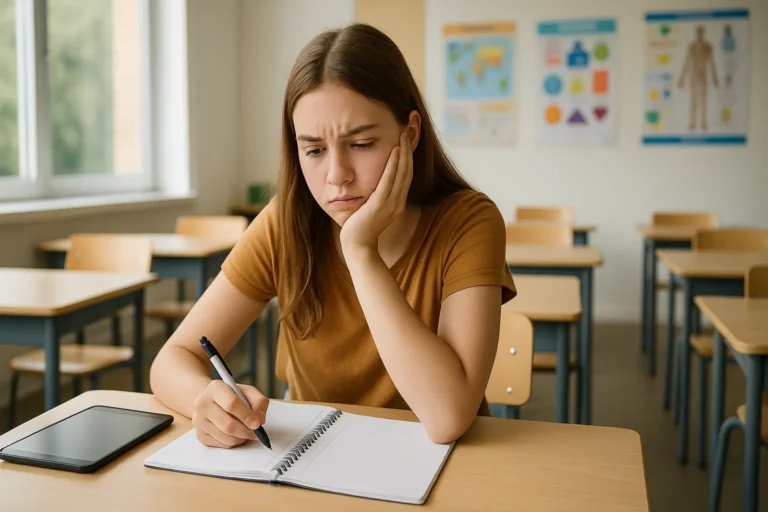ADHD Symptoms in Girls: The Ultimate Guide to Early Signs, Diagnosis, and Teen Challenges
Table of Contents
The Unique Landscape of ADHD in Girls :
Did you know that girls with ADHD are nearly twice as likely to go undiagnosed compared to boys? While ADHD (Attention-Deficit/Hyperactivity Disorder) is often associated with hyperactive little boys, ADHD symptoms in kids girls frequently go unnoticed due to differences in how they present.
Girls with ADHD often internalize their struggles, leading to missed diagnoses and years of frustration. They might be labeled as “daydreamers,” “spacey,” or “overly emotional” rather than receiving the support they need. Understanding female ADHD symptoms child is crucial because early intervention can prevent long-term academic, social, and emotional challenges.
In this guide, we’ll explore:
- How ADHD symptoms differ in girls vs. boys
- Key signs of ADHD in girls across different ages
- Why ADHD in girls is often overlooked
- Co-occurring conditions and how to seek help
Understanding ADHD Symptom Categories (With a Girl-Specific Lens)
ADHD is typically categorized into three types:
- Inattentive (struggles with focus, organization)
- Hyperactive-Impulsive (fidgeting, interrupting, restlessness)
- Combined (a mix of both)
While boys often display external hyperactivity, girls are more likely to exhibit inattentive ADHD girls symptoms, making them harder to spot.
Inattentive ADHD Symptoms in Girls :
Girls with inattentive ADHD may:
✔ Struggle to follow multi-step instructions (e.g., homework assignments)
✔ Lose items frequently (backpack, homework, shoes)
✔ Appear “zoned out” or daydreaming (but are actually overwhelmed)
✔ Avoid tasks requiring sustained mental effort (long reading assignments)
✔ Make careless mistakes despite knowing the material
Why it’s missed: Teachers may assume they’re “just shy” or “not trying hard enough.”
Hyperactive/Impulsive Symptoms in Girls :
While less common, some girls show hyperactive or impulsive traits, but in subtler ways:
✔ Fidgeting (hair twirling, nail-biting, leg shaking)
✔ Excessive talking (may dominate conversations)
✔ Emotional impulsivity (quick to cry or get frustrated)
✔ Interrupting (but excused as “enthusiasm”)
Key difference: Unlike boys who may run around, girls’ hyperactivity is often verbal or internalized.
Combined ADHD in Girls
Some girls experience both inattention and hyperactivity, leading to:
- Disorganization (messy room, forgotten deadlines)
- Social struggles (talking too much or missing social cues)
- Emotional dysregulation (mood swings, sensitivity)
Why ADHD in Girls is a “Hidden Disorder”
1. Societal Expectations & Gender Bias
Girls are often socialized to be quiet and compliant, so they mask symptoms by:
- Overcompensating (staying up all night to perfect homework)
- Mimicking peers (copying others to fit in socially)
- Internalizing struggles (anxiety, self-doubt)
2. Masking & Compensating Behaviors
Many girls develop coping mechanisms like:
- Perfectionism (to hide disorganization)
- People-pleasing (to avoid criticism)
- Social withdrawal (to avoid embarrassment)
3. Internalizing vs. Externalizing
While boys may act out, girls often turn struggles inward, leading to:
- Anxiety
- Depression
- Low self-esteem
Result: Many girls are misdiagnosed with anxiety or depression before ADHD is considered.
Age-Specific ADHD Symptoms in Girls
Preschool & Early Elementary (Ages 4-7)
- Struggles with transitions (tantrums when switching activities)
- Easily distracted (can’t follow storytime)
- Clumsiness (bumps into things frequently)
- “Spaced out” appearance (seems to daydream)
Why it’s missed: Often dismissed as “just being a kid.”
Elementary School (Ages 8-12)
- Messy desk/backpack (despite trying to stay organized)
- Forgets homework (even if she understood it in class)
- Social difficulties (misses social cues, talks excessively)
- Starts strong but can’t finish tasks
Why it’s missed: Teachers may assume she’s “not applying herself.”
Teenage Girls (Ages 13-18)
- Severe disorganization (misses deadlines despite effort)
- Emotional outbursts (quick to anger or cry)
- Risk-taking behaviors (impulsive decisions)
- Academic burnout (works hard but grades slip)
- Anxiety & depression (from years of feeling “different”)
Why it’s missed: Blamed on “hormones” or “laziness.”
The Impact Beyond Academics
ADHD affects all areas of life:
- Social struggles (difficulty keeping friends)
- Emotional health (frequent frustration, low self-worth)
- Family stress (parents may mistake symptoms for defiance)
For more on emotional impacts, see this resource from Child Mind Institute.
Co-Occurring Conditions in Girls with ADHD
Many girls have additional challenges, including:
| Condition | How It Manifests |
|---|---|
| Anxiety | Excessive worry, perfectionism |
| Depression | Low mood, fatigue |
| Learning Disabilities | Dyslexia, dyscalculia |
| Sleep Disorders | Trouble falling/staying asleep |
| Eating Disorders | Binge eating or restriction (common in teens) |
Learn more about ADHD and co-occurring conditions from ADDitude Magazine.
The Path to Diagnosis
Why Girls Are Often Misdiagnosed
- Stereotypes favor male ADHD presentations.
- Compensating behaviors hide struggles.
- Symptoms attributed to personality (“she’s just sensitive”).
Steps to Diagnosis
- Parent/teacher rating scales (Conners, Vanderbilt)
- Clinical interviews (with child & parents)
- Cognitive testing (ruling out learning disabilities)
- Rule out other conditions (anxiety, thyroid issues)
Tip: Seek a professional experienced in female ADHD diagnosis.
Actionable Next Steps for Parents & Educators
✔ Track symptoms (use a journal or app)
✔ Talk openly with your daughter (avoid blame)
✔ Request a school evaluation (504 Plan or IEP)
✔ Find an ADHD specialist (psychiatrist, psychologist)
Treatment options (briefly mentioned):
- Behavioral therapy
- Parent training
- Medication (if appropriate)
Real-Life Voices: Parents & Women with ADHD
“My daughter was called ‘lazy’ for years—turns out she had inattentive ADHD.” – Anonymous Mom
“I wasn’t diagnosed until college. I wish someone had noticed sooner.” – Sarah, 28
For more personal stories, visit Women & ADHD: Personal Experiences.
Conclusion: There’s Hope
Recognizing ADHD symptoms in kids girls early can change their lives. If you suspect ADHD:
🔹 Advocate for assessment
🔹 Seek expert guidance
🔹 Provide emotional support
With the right help, girls with ADHD can thrive academically, socially, and emotionally.
FAQ Section
Q: Can a girl have ADHD without being hyperactive?
A: Yes! Many girls have inattentive ADHD with no hyperactivity.
Q: What’s the biggest difference between ADHD in boys and girls?
A: Boys often externalize symptoms (disruptive behavior), while girls internalize them (anxiety, daydreaming).
Q: At what age do ADHD symptoms appear in girls?
A: Signs can appear as early as preschool, but many girls aren’t diagnosed until adolescence.
Q: Is ADHD in girls linked to anxiety?
A: Yes, many girls develop anxiety from trying to compensate for ADHD challenges.
Q: How can I help my daughter if she has ADHD?
A: Educate yourself, seek professional help, and provide structure & empathy.
Found this helpful? Share it with a parent or teacher who needs it! 💙
Would you like a downloadable symptom checklist for girls with ADHD? Let us know in the comments!
For further reading, check out:







